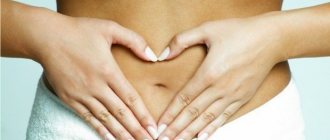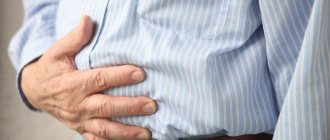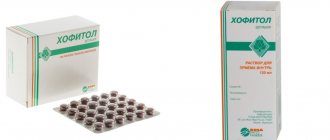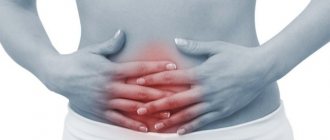Biliary sludge and sludge syndrome are two names for the same phenomenon. This pathology was discovered relatively recently, after detailed diagnosis of the body with its complete ultrasound became possible.
Initially, biliary sludge in the gallbladder occurs when bile begins to stagnate and its normal filtration is not carried out.
What is sludge syndrome and its causes?
Patients are often interested in why putty-like bile appears and what it is. Sludge in the gallbladder is detected in 1/20 of the population. It is the stagnation of a fine suspension in the lumen of the organ, consisting of protein molecules, mucoprotein, cholesterol crystals and heterogeneous salt deposits. After its occurrence, the intensity of absorption decreases, which leads to the formation of stones.
The flocculent suspension that appears in the gallbladder is dangerous because it is the first stage of cholelithiasis, which is classified as quite dangerous. The echo suspension provokes the formation of cholestasis, which over time can lead to serious complications, and in cases of high neglect, even death. The following forms of the disease exist:
- with a predominance of cholesterol crystals,
- with a predominance of calcium salts,
- with a predominant content of bilirubin.
According to another sign, the disease occurs:
- primary, develops on its own, there are no concomitant diseases,
- secondary, develops due to parallel disorders in the body.
The suspension itself is also divided into groups. She can:
- move when the body shifts,
- transform into dense putty-like clots that have the ability to move independently during the ultrasound procedure,
- combine both phenomena at the same time.
The following factors lead to the occurrence of pathology:
- sudden change in weight caused by an unbalanced diet,
- last months of pregnancy,
- diabetes,
- eating through a tube,
- surgical intervention in the digestive system,
- dropsy,
- taking certain medications that contain calcium (cephalosporins, contraceptives, lipolytics),
- hemoglobinopathy,
- diseases of the gastrointestinal tract,
- lithotripsy procedure,
- organ transplantation,
- inflammation of the pancreas,
- cholestasis,
- alcohol abuse,
- stone extraction,
- tumor neoplasms,
- cholelithiasis,
- hepatitis,
- long-term intravenous nutrition.
The following people are predisposed to the development of pathology: the female part of the population, adults over 50 years of age, overweight people, people with genetic conditions. The presence and progression of bacterial infection, which provokes sedimentation, increases the risk of pathology.
Clinical relevance
The absence of secretion makes the fats supplied with food indigestible, so they are excreted unchanged, undigested, along with feces. Pathology in the absence or severe deficiency of bile secretion is called steatorrhea. The disease often leads to a deficiency of nutrients, vitamins, and important fatty acids. The food itself, passing through the lumens of the small intestine, where fat absorption occurs, without bile, completely changes the microflora of the intestinal tract. Given the presence of cholesterol in bile, which often combines with calcium, bilirubin forms gallstones. Treatment of calculi (organic stones) occurs only surgically, which involves removing the gallbladder. If there is insufficient secretion, they resort to prescribing drugs that promote the breakdown of fats and restoration of intestinal microflora.
Gallbladder
Important! What color is bile? The color of bile is often compared to the hue of freshly cut grass, but when mixed with the components of the stomach, it produces a green-yellow or deep yellow hue.
Symptoms
The initial stage of the disease often does not manifest itself at all. Symptoms develop only after time. Gallbladder sludge syndrome has symptoms similar to chronic cholecystitis:
- pain in the right side of the body, occurring at the moment when the suspension in the bile organ begins to move and begins to affect the mucous membrane,
- loss of appetite,
- bloating,
- intoxication, manifested by elevated body temperature, headaches and fatigue,
- flatulence,
- pain in the heart area,
- rumbling in the stomach,
- obstructive jaundice, indicating a violation of the outflow of fluid through the common bile ducts,
- severe nausea
- gagging,
- a feeling of bitterness in the mouth,
- abdominal pain,
- broken stool,
- burning sensation in the digestive tract.
General information
Bile is secreted by hepatocytes - liver cells. Bile collects in the bile ducts of the liver, and from there, through the common bile duct, it enters the gallbladder and the duodenum, where it participates in the digestive processes. The gallbladder acts as a reservoir, the use of which allows the duodenum to be supplied with the maximum amount of bile during the active digestive phase, when the intestine is filled with food partially digested in the stomach.
Bile secreted by the liver (part of it goes directly to the duodenum) is called “hepatic” (or “young”), and bile secreted by the gallbladder is called “vesical” (or “mature”).
The human liver secretes up to 2 liters of bile per day[4].
General characteristics of hepatic and cystic bile
[5]
| Options | Hepatic bile | Bile bile |
| Acidity, | 7,3 — 8,2 | 6,5 — 6,8 |
| Specific gravity | 1,01 — 1,02 | 1,02 — 1,048 |
| Dry residue, g/l | 26,0 | 133,5 |
| Water, % | 95 — 97 | 80 — 86 |
Sludge syndrome in children
Sludge syndrome is common in children. Its cause is jaundice, which occurs in many newborns. This phenomenon is caused by an increase in bilirubin in children, which leads to the appearance of heterogeneous flakes. If a child has an unbalanced diet consisting of unnatural food, then the risk of developing pathology increases significantly.
Frequent consumption of artificial foods and stress due to school also contribute to the development of the disease in adolescents. Experts recommend carefully monitoring the diet of schoolchildren and filling it with a full range of microelements that have a choleretic effect.
If symptoms of pathology appear, the child should be immediately taken to a doctor, since complications occur more often in children.
Diagnosis of suspension in the gallbladder
It is necessary to diagnose suspensions in the gallbladder at the earliest stages of their formation, as they can lead to serious consequences. The contents of the gallbladder at different stages of the disease are determined differently:
- echogenic suspension is visualized as flakes in the gallbladder, having a heterogeneous composition,
- hyperechoic suspension looks like a thicker structure, of heterogeneous consistency, presented in the form of clots,
- biliary sludge, which is a full-fledged mobile sediment with an even contour, consisting of calcium salts, pigments and fatty molecules.
The initial diagnosis is made based on the patient's medical history. The main attention is paid to his medical history, lifestyle and bad habits. Next, a physical examination is carried out to identify any painful sensations in the stomach and assess the size of the digestive organs.
The most common laboratory diagnostic method is a biochemical blood test for cholesterol, bilirubin and transamine. General tests of stool and urine are used.
The main instrumental method is ultrasound. An ultrasound can show the presence of stones and evaluate the consistency of bile. Microscopic examination of bile, computed tomography, magnetic resonance imaging and duodenal intubation are also popular, helping to diagnose disorders in the biliary system.
Stages of sludge formation
Sludge formation occurs in stages.
Each period can be short or, on the contrary, take several years. It all depends on the concentration of bile, existing concomitant pathologies, and diet. At the first stage, the concentration of bile occurs, its saturation with cholesterol. Subsequently, the particles of lipophilic alcohol combine and settle on the walls of the bladder cavity. New particles continue to attach there. Clusters increase in size. A sediment forms in the gallbladder.
Biliary sludge can be primary or secondary. In the first case, the formation of a suspension is spontaneous. Secondary sediment is the result of certain diseases (inflammatory processes in the gallbladder, pancreatitis).
The formation of sludge can both cause the development of gallstone disease and become its consequence.
Starting therapy at any stage of sediment formation can stop the process. If the sludge “grows” into stones, the bubble may be removed and complications may develop.
How and by what type sludge progresses is largely determined by a person’s general health, diet, gender, and age.
Treatment of suspension in the gallbladder
When making an accurate diagnosis, it is necessary to contact a gastroenterologist who is involved in further treatment of the patient. Treatment is based on returning bile to its normal state, relieving pain and reducing the risk of complications.
Therapy can be carried out in three different ways, prescribed depending on the degree of functioning of the common bile ducts:
- In mild cases of the disease, patients are prescribed a special diet No. 5 and a course of medications to treat the causes of bile in the gallbladder. This stage is easily reversible.
- The largest group of patients who have a sediment in the gallbladder are prescribed conservative therapy. It is based on a regimen of taking medications that help get rid of bile stagnation and have a protective function of the excretory channels. Often, such patients are also prescribed a diet that helps with bile stagnation.
- In the most severe cases, surgery is used.
Functional Features
So, what is bile for and what functions does it perform? Bile has a special biological value in the human body. This glandular secretion is assigned by nature many different functions that completely regulate the following processes in the body:
- neutralizing the effect of pepsin, a component of gastric juice;
- participation in the production of micelles;
- activation of regeneration of hormonal processes in the intestines;
- participation in the emulsification of fatty components and the production of mucus;
- maintaining motility of the digestive organs;
- easy digestion of protein.
Liver and bile ducts
All enzymatic functions of bile ensure the normal passage of food through the food passages, break down complex fats, proteins, carbohydrates, and ensure the maintenance of normal microflora in the liver and gall bladder. Other important functions of bile in the body include the following:
- providing bile to the cavity of the small intestine;
- ensuring normal metabolic processes;
- production of synovial fluid (shock-absorbing secretion of interarticular structures).
With minor changes in the composition of bile, many systems fail, provoking the formation of stones in the ducts of the gallbladder and in its cavity, improper formation of feces, reflux of bile secretions and other pathologies.
Important! Changes in the composition of bile can be influenced by the patient's obesity, complicated endocrinological history, sedentary lifestyle, and severe liver diseases. Functional disorders of the gallbladder provoke the persistent development of its hyperfunction or insufficiency.
Prevention and diet
Pathology is often a consequence of insufficient physical activity. An excellent preventive measure is moderate physical activity - walking, morning exercises, cycling, swimming.
Avoiding stressful situations, maintaining a healthy lifestyle, maintaining a healthy diet and getting rid of bad habits will help prevent the risk.
The main prevention is special dietary food No. 5. The diet should be based on the consumption of the following foods:
- decoctions of fresh vegetables,
- fermented milk products,
- Rye bread,
- lean meat,
- boiled fish,
- porridge,
- natural juices,
- honey,
- natural tea,
- jam.
It is unacceptable to consume such products as:
- radish,
- smoked meats,
- alcoholic drinks,
- cranberry,
- sauces,
- black coffee,
- flour products,
- cocoa,
- canned food,
- mustard,
- fatty fish and meats,
- caviar,
- sorrel,
- spices,
- fried foods,
- eggs,
- cold drinks,
- carbonated drinks,
- mayonnaise,
- spinach,
- ice cream,
- chocolate products,
- pickled vegetables,
- onion.
The diet should be based on the following principles:
- Fractionality. Daily meals should be divided into 6 parts.
- Maintaining the correct temperature. The food should be warm. Not hot.
- Moderation. Overeating should be avoided.
- Dishes must be prepared so that all the necessary microelements are in the correct ratio.
- Consistency. You should eat at the same time every day.
- Useful heat treatment based on cooking, stewing and avoiding oil when baking.
- Drink fluid in the recommended amount, but not less than two liters per day.
If the disease has already formed and is actively progressing, then the diet should be prescribed by the attending physician, who, when selecting products, will be guided by the individual characteristics of the patient’s body and will help choose the optimal diet option.
It is important to monitor the condition of the biliary system as a whole. Any disruptions in the functioning of the liver require immediate diagnosis and medical attention. If you have other diseases and their drug therapy, you should strictly adhere to the dosages of medications prescribed by your doctor.
Possible complications
Congestion can lead to the progression of a number of severe complications:
- Cholecystitis.
- Cholestasis.
- Inflammation of the pancreas.
- Severe pain syndrome.
- Acute cholangitis.
This disease is classified as dangerous. Its neglect almost always leads to death or to the development of cirrhosis, the worst outcome of which is also death. When the first symptoms appear, you must immediately contact a medical facility for an accurate diagnosis and prescribe the optimal course of treatment. This pathological condition is especially dangerous for children and adolescents, whose unformed organisms are not able to provide effective resistance.










